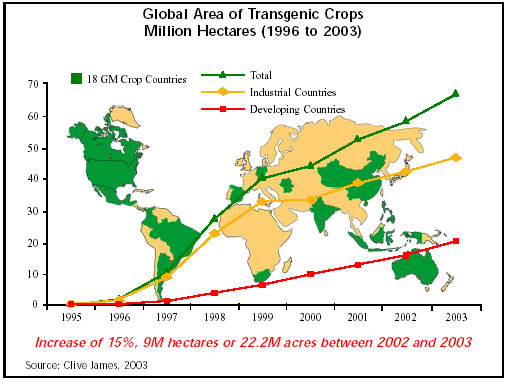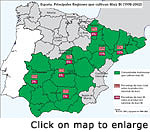Manila, The Philippines
January 13, 2004
For the seventh consecutive year, farmers around the world
continued to plant biotech crops at a double-digit pace, with
the 2003 total up 15 percent to 167.2 million acres or 67.7
million hectares, according to a report released today by the
International Service for the
Acquisition of Agri-biotech Applications (ISAAA).

The increase includes a provisional conservative estimate of
7.41 million acres or 3 million hectares of biotech soybeans in
Brazil, which approved planting of biotech soybeans for the
first time in 2003. The final planted area in
Brazil
could be significantly higher.
The report also stated that 7 million farmers in 18 countries —
more than 85 percent resource-poor farmers in the developing
world — now plant biotech crops, up from 6 million in 16
countries in 2002. Almost one-third of the global biotech crop
area was grown in developing countries, up from one-quarter last
year.
“
Farmers have made up their minds,” said Clive James, chairman
and founder of ISAAA. “They continue to rapidly adopt biotech
crops because of significant agronomic, economic, environmental
and social advantages.”
The number of countries responsible for 99 percent of the global
biotech crop area expanded to six, up from four in 2002,
according to the report. Brazil and South Africa joined the
United States, Argentina, Canada and China as the leading
growers of biotech crops.
China
and South Africa experienced the greatest annual increase, with
both countries planting one-third more biotech hectares than in
2002. The remaining top 10 countries planting more than 50,000
hectares are
Australia,
India, Romania and Uruguay; another eight countries each plant
up to 50,000 hectares of biotech crops.
In
the United States, biotech crop acreage grew 10 percent as a
result of significant gains in biotech corn area and continued
growth in biotech soybeans. A total of 105.7 million acres of
soybeans, corn and cotton were grown. Farmer Ray Bardole, who
raises more than 600 acres of no-till biotech soybeans on his
farm near Rippey, Iowa, says he plants biotech crops because of
the economic and environmental advantages they afford.
Global Biotech Crop Hectarage
“Current biotech crops are to agriculture what the Model T Ford
is to modern transportation — we’re only beginning to see the
benefits,” Bardole said. “We’re spending one-half to one-third
what we used to on weed control, and we’re able to use more
techniques like no-till that help us be better stewards of our
land.”
Biotech soybeans continue to lead all hectares globally with an
increase of nearly 13 percent to 102.2 million acres — 55
percent of soybeans globally. New varieties and country
approvals spurred the greatest growth in the area planted to
biotech maize, with an increase of 25 percent to a total of 38.3
million acres worldwide — 11 percent of the global maize area.
Canola followed with 20 percent growth for a total of 8.9
million acres — 16 percent of canola hectarage globally. Biotech
cotton was up approximately 6 percent to a total of 9.7 million
acres — 21 percent of the global cotton area.
“
Despite the ongoing debate in the European Union, there is cause
for cautious optimism that the global area of biotech crops and
the number of farmers planting them will continue to grow in
2004 and beyond,” James said.
Within the next five years, ISAAA predicts 10 million farmers in
25 or more countries will plant 100 million hectares or
247,000,000 acres of biotech crops. According to the report, the
global market value of biotech crops is expected to increase
from approximately $4.5 billion this year to $5 billion or more
by 2005.
Click HERE for
the
Executive Summary of the report (ISAAA Briefs 30, by Clive
James) can be accessed at
http://www.isaaa.org/Press_release/Briefs30-2003/es_b30.pdf
 The International Service for the Acquisition of Agri-biotech
Applications (ISAAA) is a not-for-profit organization with an
international network of centers designed to contribute to the
alleviation of hunger and poverty by sharing crop biotechnology
applications. Clive James, chairman and founder of ISAAA, has
lived and worked for the past 25 years in the developing
countries of Asia, Latin America and Africa, devoting his
efforts to agricultural research and development issues. Lately,
his focus is crop biotechnology and global food security. The International Service for the Acquisition of Agri-biotech
Applications (ISAAA) is a not-for-profit organization with an
international network of centers designed to contribute to the
alleviation of hunger and poverty by sharing crop biotechnology
applications. Clive James, chairman and founder of ISAAA, has
lived and worked for the past 25 years in the developing
countries of Asia, Latin America and Africa, devoting his
efforts to agricultural research and development issues. Lately,
his focus is crop biotechnology and global food security.
Biotech Crop Area
by Country (1
hectare = 2.47 acres)
The United States
planted 105.7 million acres of biotech crops, up 10 percent from
2002, and accounted for 63 percent of the global total of
biotech crops. The continued growth was a result of significant
acreage gains in biotech corn varieties and continued increases
in herbicide-tolerant soybeans.
Argentina
contributed 34.3 million acres of biotech crops, 3 percent above
2002 and 21 percent of the global total of biotech crops. Bt
maize acreage continued to grow, while biotech soybean acreage
accounts for nearly 100 percent of the crop.
Canada grew
10.9 million acres of biotech crops for 6 percent of the global
total, up 26 percent from 2002. The high growth rate reflects
higher plantings of canola and significant growth in both
biotech maize and herbicide-tolerant soybeans.
Brazil,
planting biotech soybeans for the first time, contributed 4
percent of the global total at 7.4 million acres. This is a
conservative provisional estimate as only half of the area was
planted at the time of this report. The final area could be
significantly higher.
China grew 6.9
million acres of biotech cotton (58 percent of the national
cotton crop), an increase of 33 percent above 2002 and 4 percent
of the total global area of biotech crops.
South Africa
planted approximately 988,000 acres of biotech crops, up 33
percent from last year and 1 percent of the global total of
biotech crops. The increase is from gains in biotech white and
yellow maize, cotton and soybeans.
While biotech crop
acreage decreased slightly in
Australia due
to the continuing drought that resulted in significantly reduced
planting overall, farmers still planted approximately 247,000
acres of biotech cotton.
In its second year of
biotech crop production,
India doubled
Bt cotton acreage to about 247,000 acres in 2003.
Uruguay and Romania
reported significant growth in biotech crop acreage.
Romania
increased biotech soybean hectarage by half to 172,900 acres.
Uruguay tripled its biotech soybean acres to 148,200
hectares and commercially planted Bt maize for the first time.
 Spain remained
the only country in the European Union to plant significant
acreage of biotech crops with 79,000 acres of Bt maize, an
increase of 33 percent from last year. Spain remained
the only country in the European Union to plant significant
acreage of biotech crops with 79,000 acres of Bt maize, an
increase of 33 percent from last year.
Elsewhere in Europe,
Germany continued to grow a small area of Bt maize, and
Bulgaria
continued to grow a few thousand acres of herbicide-tolerant
maize.
The Philippines
grew biotech crops for the first time in 2003 with nearly 50,000
acres of Bt maize — the first biotech food/feed crop to be grown
in Asia.
Reports from
Indonesia indicate farmers planted a small area of Bt cotton
in Sulawesi.
Colombia
expanded its area of Bt cotton to about 12,000 acres during its
second year of biotech production.
Honduras
expanded its Bt maize plantings in 2003 to nearly 5,000 acres
from a pre-commercial introductory area of just more than 1,000
acres of Bt maize in 2002.
Mexico grew
about 62,000 hectares of Bt cotton and approximately 25,000
acres of herbicide-tolerant soybeans.
|